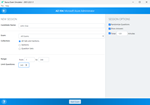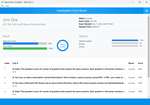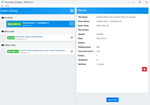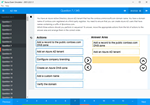Download vSphere 6 Foundations.2V0-620.PracticeDumps.2018-05-16.107q.tqb
| Vendor: | VMware |
| Exam Code: | 2V0-620 |
| Exam Name: | vSphere 6 Foundations |
| Date: | May 16, 2018 |
| File Size: | 1 MB |
How to open TQB files?
Files with TQB (Taurus Question Bank) extension can be opened by Taurus Exam Studio.
Purchase
Coupon: TAURUSSIM_20OFF
Discount: 20%
Demo Questions
Question 1
How many Link Aggregation Groups (LAGs) can be configured on a vSphere 6.x Distributed Switch?
- 64
- 96
- 128
- 256
Correct answer: A
Explanation:
You can create up to 64 LAGs on a distributed switch. A host can support up to 32 LAGs. However, the number of LAGs that you can actually use depends on the capabilities of the underlying physical environment and the topology of the virtual network. For example, if the physical switch supports up to four ports in an LACP port channel, you can connect up to four physical NICs per host to a LAG. Reference: https://pubs.vmware.com/vsphere-55/index.jsp?topic=%2Fcom.vmware.vsphere.networking.doc%2FGUID-0D1EF5B4-7581-480B-B99D-5714B42CD7A9.html You can create up to 64 LAGs on a distributed switch. A host can support up to 32 LAGs. However, the number of LAGs that you can actually use depends on the capabilities of the underlying physical environment and the topology of the virtual network. For example, if the physical switch supports up to four ports in an LACP port channel, you can connect up to four physical NICs per host to a LAG.
Reference: https://pubs.vmware.com/vsphere-55/index.jsp?topic=%2Fcom.vmware.vsphere.networking.doc%2FGUID-0D1EF5B4-7581-480B-B99D-5714B42CD7A9.html
Question 2
An administrator is configuring the Failover Order option on a vSphere Distributed Switch.
Which two options should be used with IP-hash load balancing? (Choose two.)
- Active Uplinks
- Standby Uplinks
- Unused Uplinks
- Override Failover Order
Correct answer: AC
Explanation:
Active Uplinks, and Unused adapter Uplinks are used with IP hash load balancing. Reference: https://books.google.com.pk/books?id=35TE4cSycNAC&pg=PA201&lpg=PA201&dq=IP+hash+load+balancing+active+uplinks+unused+uplinks&source=bl&ots=ggg8VOCpw4&sig=EaqvN49-p2UWQ5b6V53SkFFmJhc&hl=en&sa=X&ved=0ahUKEwiv1ruEhMbNAhVGL48KHfXaBN4Q6AEIUzAJ#v=onepage&q=IP%20hash%20load%20balancing%20active%20uplinks%20unused%20uplinks&f=false Active Uplinks, and Unused adapter Uplinks are used with IP hash load balancing.
Reference: https://books.google.com.pk/books?id=35TE4cSycNAC&pg=PA201&lpg=PA201&dq=IP+hash+load+balancing+active+uplinks+unused+uplinks&source=bl&ots=ggg8VOCpw4&sig=EaqvN49-p2UWQ5b6V53SkFFmJhc&hl=en&sa=X&ved=0ahUKEwiv1ruEhMbNAhVGL48KHfXaBN4Q6AEIUzAJ#v=onepage&q=IP%20hash%20load%20balancing%20active%20uplinks%20unused%20uplinks&f=false
Question 3
An administrator is creating a new vSphere Distributed Switch that will be utilized with a specific vSphere Cluster. The cluster itself contains a mix of ESXi 5.x and 6.x Hosts.
Which Distributed Switch version should be created to support this configuration?
- Distributed Switch: 6.0.0
- Distributed Switch: 5.0.0
- Distributed Switch: 5.1.0
- Distributed Switch: 5.5.0
Correct answer: B
Explanation:
Reference: https://pubs.vmware.com/vsphere-51/index.jsp?topic=%2Fcom.vmware.vsphere.networking.doc%2FGUID-09176C71-1748-460B-BB7B-3671AB855D7E.html 
Reference: https://pubs.vmware.com/vsphere-51/index.jsp?topic=%2Fcom.vmware.vsphere.networking.doc%2FGUID-09176C71-1748-460B-BB7B-3671AB855D7E.html
Question 4
During a new vSphere Distributed Switch configuration, where does the Maximum Transmission Unit (MTU) value get modified?
- Uplink Settings
- Switch Settings
- Portgroup Settings
- NIC Teaming Settings
Correct answer: B
Explanation:
You can modify MTU values in switch settings. Reference: https://kb.vmware.com/selfservice/microsites/search.do%3Flanguage%3Den_US%26cmd%3DdisplayKC%26externalId%3D1010557 You can modify MTU values in switch settings.
Reference: https://kb.vmware.com/selfservice/microsites/search.do%3Flanguage%3Den_US%26cmd%3DdisplayKC%26externalId%3D1010557
Question 5
Which two actions are prerequisites to adding ESXi 6.x hosts to a vSphere Distributed Switch? (Choose two.)
- Verify that there is at least one Distributed Port Group on the Distributed Switch.
- Verify that the Distributed Port Group have active uplinks configured in its teaming and failover policy.
- Verify that the Distributed Switch has been configured with a Network Profile.
- Verify that Network I/O control for Management Traffic is configured for the highest share value.
Correct answer: AB
Explanation:
To manage the networking of your vSphere environment by using a vSphere Distributed Switch, you must associate hosts with the switch. You connect the physical NICs, VMkernel adapters, and virtual machine network adapters of the hosts to the distributed switch. Prerequisites Verify that enough uplinks are available on the distributed switch to assign to the physical NICs that you want to connect to the switch. Verify that there is at least one distributed port group on the distributed switch. Verify that the distributed port group have active uplinks configured in its teaming and failover policy. Reference: https://pubs.vmware.com/vsphere-60/index.jsp?topic=%2Fcom.vmware.vsphere.networking.doc%2FGUID-E90C1B0D-82CB-4A3D-BE1B-0FDCD6575725.html To manage the networking of your vSphere environment by using a vSphere Distributed Switch, you must associate hosts with the switch. You connect the physical NICs, VMkernel adapters, and virtual machine network adapters of the hosts to the distributed switch.
Prerequisites
- Verify that enough uplinks are available on the distributed switch to assign to the physical NICs that you want to connect to the switch.
- Verify that there is at least one distributed port group on the distributed switch.
- Verify that the distributed port group have active uplinks configured in its teaming and failover policy.
Reference: https://pubs.vmware.com/vsphere-60/index.jsp?topic=%2Fcom.vmware.vsphere.networking.doc%2FGUID-E90C1B0D-82CB-4A3D-BE1B-0FDCD6575725.html
Question 6
Which load balancing policy, previously limited to vSphere Distributed Switches, is now available on vSphere Standard Switches with vSphere 6.x?
- Route based on physical NIC workload
- Route based on IP Hash
- Route based on the originating virtual port
- Route based on Source MAC Hash
Correct answer: A
Explanation:
Route based on physical NIC workload was limited to vSphere Distributed switches. Now its available on vSphere standard switches with vSphere 6.x Reference: https://pubs.vmware.com/vsphere-60/topic/com.vmware.ICbase/PDF/vsphere-esxi-vcenter-server-60-networking-guide.pdf Route based on physical NIC workload was limited to vSphere Distributed switches. Now its available on vSphere standard switches with vSphere 6.x
Reference: https://pubs.vmware.com/vsphere-60/topic/com.vmware.ICbase/PDF/vsphere-esxi-vcenter-server-60-networking-guide.pdf
Question 7
Which three VLAN Tagging modes are available in vSphere 6.x? (Choose three.)
- External Switch Tagging
- Private VLAN Tagging
- Virtual Switch Tagging
- VXLAN Tagging
- Virtual Guest Tagging
Correct answer: ACE
Explanation:
There are 3 types of tagging available in vSphere. Virtual Switch Tagging (VST) External Switch Tagging (EST) Virtual Guest Tagging (VGT) VLAN tagging is determined by the VLAN value specified at the port group and it tells the vSwitch or Phyiscal switch or Virtual machines to how to handle the VLAN tagging. Reference: http://www.vmwarearena.com/vlan-tagging-vst-est-vgt-on-vmware/ There are 3 types of tagging available in vSphere.
- Virtual Switch Tagging (VST)
- External Switch Tagging (EST)
- Virtual Guest Tagging (VGT)
VLAN tagging is determined by the VLAN value specified at the port group and it tells the vSwitch or Phyiscal switch or Virtual machines to how to handle the VLAN tagging.
Reference: http://www.vmwarearena.com/vlan-tagging-vst-est-vgt-on-vmware/
Question 8
Which three traffic types are available services options when configuring a vmkernel port? (Choose three.)
- Provisioning Traffic
- Virtual Volumes Traffic
- vSphere Replication NFC Traffic
- Virtual SAN Traffic
- FCoE Traffic
Correct answer: ACD
Explanation:
You can enable services for the default TCP/IP stack on the host. Select from the available services:vMotion traffic. Enables the VMkernel adapter to advertise itself to another host as the network connection where vMotion traffic is sent. The migration with vMotion to the selected host is not possible if the vMotion service is not enabled for any VMkernel adapter on the default TCP/IP stack, or if no adapters are using the vMotion TCP/IP stack. Provisioning traffic. Handles the data transferred for virtual machine cold migration, cloning, and snapshot creation. Fault Tolerance traffic. Enables Fault Tolerance logging on the host. You can use only one VMkernel adapter for FT traffic per host. Management traffic. Enables the management traffic for the host and vCenter Server. Typically, hosts have such a VMkernel adapter created when the ESXi software was installed. You can create another VMkernel adapter for management traffic on the host to provide redundancy. vSphere Replication traffic.Handles the outgoing replication data that is sent from the sourceESXi host to the vSphere Replication server. vSphere Replication NFC traffic. Handles the incoming replication data on the target replication site. Virtual SAN. Enables the Virtual SAN traffic on the host. Every host that is part from a Virtual SAN cluster must have such a VMkernel adapter. Reference: https://pubs.vmware.com/vsphere-60/index.jsp?topic=%2Fcom.vmware.vsphere.networking.doc%2FGUID-1C0D8D8D-F9A5-4443-9AE7-544742630D39.html You can enable services for the default TCP/IP stack on the host. Select from the available services:
vMotion traffic. Enables the VMkernel adapter to advertise itself to another host as the network connection where vMotion traffic is sent. The migration with vMotion to the selected host is not possible if the vMotion service is not enabled for any VMkernel adapter on the default TCP/IP stack, or if no adapters are using the vMotion TCP/IP stack.
- Provisioning traffic. Handles the data transferred for virtual machine cold migration, cloning, and snapshot creation.
- Fault Tolerance traffic. Enables Fault Tolerance logging on the host. You can use only one VMkernel adapter for FT traffic per host.
- Management traffic. Enables the management traffic for the host and vCenter Server. Typically, hosts have such a VMkernel adapter created when the ESXi software was installed. You can create another VMkernel adapter for management traffic on the host to provide redundancy.
- vSphere Replication traffic.Handles the outgoing replication data that is sent from the sourceESXi host to the vSphere Replication server.
- vSphere Replication NFC traffic. Handles the incoming replication data on the target replication site.
- Virtual SAN. Enables the Virtual SAN traffic on the host. Every host that is part from a Virtual SAN cluster must have such a VMkernel adapter.
Reference: https://pubs.vmware.com/vsphere-60/index.jsp?topic=%2Fcom.vmware.vsphere.networking.doc%2FGUID-1C0D8D8D-F9A5-4443-9AE7-544742630D39.html
Question 9
Which two networking connection types can be configured on a virtual switch? (Choose two.)
- Virtual machine portgroups
- VMkernel services (such as NFS, iSCSI, or vMotion) to the physical network
- Web services over the Management Network
- NFS and FCoE storage services
Correct answer: AB
Explanation:
Virtual machine portgroups and Vmkernel services can be configured on a virtual switch. Reference: https://www.vmware.com/files/pdf/virtual_networking_concepts.pdf Virtual machine portgroups and Vmkernel services can be configured on a virtual switch.
Reference: https://www.vmware.com/files/pdf/virtual_networking_concepts.pdf
Question 10
An administrator is configuring the Maximum Transmission Unit value on a vSphere Distributed Switch.
Which two options are typical values for ESXi networking? (Choose two.)
- 1492
- 1500
- 9000
- 9089
Correct answer: BC
Explanation:
To configure Jumbo Frames on a vDS using vSphere Client on vCenter Server 5.1 and earlier:From vCenter Server click, click Home > Inventory > Networking. Right-click the vDS and click Edit Settings. On the Properties tab, select the Advanced option. Change the Maximum MTU value from the default value of 1500 to 9000. This enables Jumbo Frames on all portgroups and ports. Reference: https://kb.vmware.com/selfservice/microsites/search.do?language=en_US&cmd=displayKC&externalId=1038827 To configure Jumbo Frames on a vDS using vSphere Client on vCenter Server 5.1 and earlier:
- From vCenter Server click, click Home > Inventory > Networking.
- Right-click the vDS and click Edit Settings.
- On the Properties tab, select the Advanced option.
- Change the Maximum MTU value from the default value of 1500 to 9000. This enables Jumbo Frames on all portgroups and ports.
Reference: https://kb.vmware.com/selfservice/microsites/search.do?language=en_US&cmd=displayKC&externalId=1038827
HOW TO OPEN VCE FILES
Use VCE Exam Simulator to open VCE files

HOW TO OPEN VCEX FILES
Use ProfExam Simulator to open VCEX files


ProfExam at a 20% markdown
You have the opportunity to purchase ProfExam at a 20% reduced price
Get Now!



